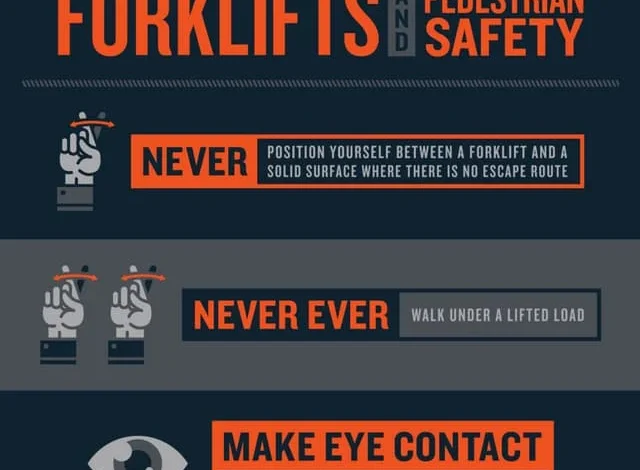Forklift and Pedestrian Safety Toolbox Talk:

Introduction
Welcome to our Forklift and Pedestrian Safety Toolbox Talk. In any workplace where forklifts are used, ensuring the safety of both operators and pedestrians is paramount. Forklift accidents can result in serious injuries or even fatalities, making it crucial to prioritize safety measures. This toolbox talk aims to highlight the importance of forklift and pedestrian safety in the workplace and provide essential guidelines for maintaining a safe environment. We’ll discuss key safety protocols, potential hazards, and best practices to mitigate risks. By adhering to these safety guidelines, we can create a workplace where everyone feels confident and secure while carrying out their tasks. Let’s dive into this toolbox talk format to ensure that safety remains our top priority.
Understanding Forklift Safety
Welcome to the section on Understanding Forklift Safety. Forklifts are indispensable tools in many workplaces, but they also pose significant risks if not operated safely. In this segment, we’ll delve into the key principles of forklift operation, equipping both operators and pedestrians with essential knowledge for safe interaction in the workplace. We’ll explore the common hazards and risks associated with forklift use, ranging from tip-overs to collisions, and discuss proactive measures to mitigate these risks. By understanding and adhering to these safety protocols, we can ensure a safer work environment for everyone involved. Let’s begin our journey to comprehensively understand forklift safety.
Pedestrian Safety Measures
Welcome to the section on Pedestrian Safety Measures. In any workplace where forklifts are present, it’s crucial to prioritize the safety of pedestrians who share the same space. This segment focuses on equipping pedestrians with the knowledge and tools necessary to navigate their environment safely. We’ll discuss the importance of being aware of pedestrian routes and designated walkways to avoid potential hazards. Additionally, we’ll explore effective communication methods between forklift operators and pedestrians, emphasizing the need for clear signals and an understanding of hand signals or audible warnings. Furthermore, we’ll highlight the significance of visibility aids such as high-visibility clothing and warning signs to enhance safety in shared work areas. By implementing these pedestrian safety measures, we can create a workplace where everyone can move about confidently and securely.
Interactive Discussion Points
Welcome to our Interactive Discussion Points segment, where we engage in dynamic conversations to enhance safety awareness in the workplace. By delving into scenario-based discussions on real-life safety incidents, we can gain valuable insights into potential risks and how to effectively address them. These discussions allow us to learn from past experiences and proactively implement measures to prevent similar incidents from occurring in the future. Additionally, through group activities, we reinforce safety protocols and emergency procedures interactively and engagingly. By actively participating in these activities, we not only strengthen our understanding of safety practices but also foster a culture of collaboration and accountability. Let’s dive into these interactive discussion points to ensure that safety remains our top priority in the workplace.
Q&A Session
Welcome to our Q&A Session, where we address your questions and concerns regarding forklift and pedestrian safety in the workplace. This session provides an opportunity for participants to voice any uncertainties or seek clarification on safety guidelines and best practices. We understand that clear communication is essential for promoting a safe work environment, which is why we’re here to provide answers and guidance. Whether you’re unsure about specific safety protocols or seeking clarification on best practices, we aim to ensure that you feel confident and equipped to prioritize safety in your daily tasks. Let’s use this Q&A session to foster open dialogue and reinforce our commitment to forklift and pedestrian safety.
Conclusion
In wrapping up our toolbox talk on forklift and pedestrian safety, let’s recap the important points we’ve covered today. First, we discussed the key principles of forklift operation, including how to safely maneuver the vehicle and avoid common hazards like tip-overs and collisions. We also highlighted the importance of pedestrian safety, emphasizing the need for awareness of designated walkways and effective communication between forklift operators and pedestrians.
Throughout our discussion, we’ve emphasized the commitment to safety in the workplace. By implementing safety protocols and following best practices, we can create a work environment where everyone feels secure and protected from potential risks. Remember, safety is everyone’s responsibility, whether you’re operating a forklift or walking through the workplace.
As we conclude, let’s reinforce our commitment to forklift and pedestrian safety. Let’s pledge to prioritize safety in everything we do, from operating machinery to navigating our work environment. By working together and staying vigilant, we can ensure that everyone goes home safely at the end of the day. Thank you for participating in this toolbox talk, and remember, safety first!penguintalks.com





